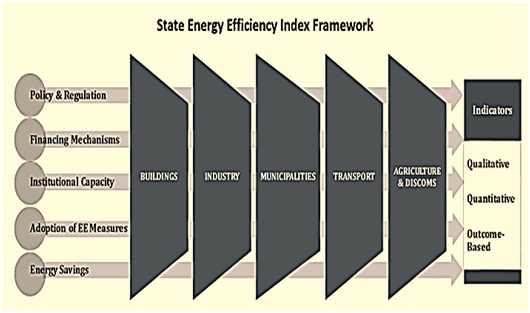State Energy Efficiency Index -2019
- 14 Jan 2020
- Recently, the Union Power Ministry released the State Energy Efficiency Index 2019, which tracks the progress of Energy Efficiency (EE) initiatives in 36 states and union territories based on 97 significant indicators.
Objectives
- Help drive EE policies and program implementation at state and local level.
- Highlight best practices and encourage healthy competition among states.
- Tracking progress in managing the state’s and India’s energy footprint.
- Institutionalizing data capture and monitoring of energy efficiency activities by states.
- Set a baseline for Efforts and provide a foundation to set state specific EE targets.
About the Index
- The index is developed by Bureau of Energy Efficiency (BEE) in association with Alliance for an Energy Efficient Economy (AEEE).
- The first such Index, the "State Energy Efficiency Preparedness Index 2018", was launched on 1st August, 2018.
- The 2019 index incorporates qualitative, quantitative and outcome-based indicators to assess energy efficiency initiatives, programs and outcomes in five distinct sectors-buildings, industry, municipalities, transport, agriculture, and DISCOMs.
- New indicators for this year include adoption of Energy Conservation Building Code (ECBC) 2017, energy efficiency in MSME clusters, etc.
- The index also examines state’s policies and regulations, financing mechanisms, institutional capacity, adoption of energy efficiency measures and energy savings achieved.

Key Highlights
- Based on their efforts and achievements, states have been classified as ‘Front Runner’, ‘Achiever’, ‘Contender’ and ‘Aspirant’.
- The top performing states for 2019 Index- Haryana, Kerala and Karnataka, are in the ‘Achiever’ category.
- Manipur, Jammu & Kashmir, Jharkhand and Rajasthan performed the worst in the Aspirant groups.
- Since there isn’t any ‘Front Runner’ state, it can be inferred that a lot more can be done at state level to realise energy savings from energy efficiency.
- For a rational comparison, the States or Union Territories are grouped into four groups based on the aggregated Total Primary Energy Supply (TPES) required to meet the state’s actual energy demand (electricity, coal, oil, gas, among others) across sectors.
- Under four categories based on TPES, Haryana, Kerala, Karnataka, Maharashtra, Himachal Pradesh, Uttarakhand, Puducherry and Chandigarh have been evaluated as progressive states/UTs in the State Energy Efficiency Index 2019.
Three-Point Agenda for StatesBased on the analysis of responses submitted by states this year, a three-point agenda is suggested for consideration by state agencies: Proactive Role by States in Policy Formulation and Implementation
Strengthening the Mechanism for Data Capture, Management and Public Availability of Data
Enhancing the Credibility of EE Schemes
|
Significance
- The Index will help states to contribute towards national goals on energy security and climate action by helping drive Energy Efficiency policies and programmme implementation at the state and local level.
- It will help in identification of potentially successful programmes (based upon best practices), and increase awareness amongst SDAs and other state entities. This would eventually lead to more budget allocation and monitoring of programmes at the state level, there by fostering development of the entire ecosystem, including increased staff dedicated to energy efficiency in the states.
- Finally, the Index will help determine India’s progress in managing energy footprint, whose criticality can not be overstated especially against the backdrop of India’s commitment to the Paris Agreement.


